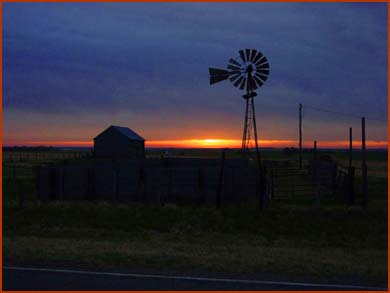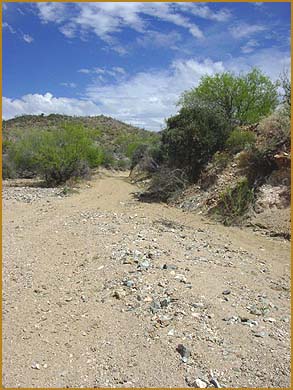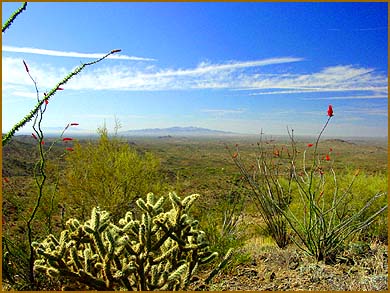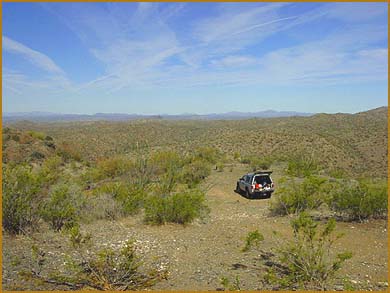Tuesday morning marked the beginning of a two-day drive to Wickenburg, Arizona.
The sun finally decided to rise about 15 minutes after we hit the road.

Oklahoma Sunrise
While I was setting up to take the above picture, I looked up the road to see
some sort of critter scampering in my direction. "Wait a minute", I said to myself . . . "that's
a SKUNK!!!!!!" Just as I turned to run in the opposite direction toward the safety of the truck,
the skunk disappeared into a hole next to the highway. It seems that he wasn't any more thrilled
to see me than I was to see him. And no, I didn't have the presence of mind to take a picture of
Pepé Le Pew's American cousin.
We drove all Tuesday into a fierce headwind that mercifully let up by
Wednesday morning. That afternoon we arrived and set up at the very well kept Desert Cypress RV & Mobile
home park in Wickenburg. This extremely nice place would be our home for the following 4 nights.

We were very excited when we woke up on Thursday morning. We had been
anxious for many months to visit the Monarch Mine located in the desert about 6 miles from
Wickenburg. This was our first Arizona backroading adventure of the trip. When I say "backroading"
in this region of the country, what I am really referring to is driving on treacherous
4-wheel drive-only desert roads and washes to get to remote rockhounding locations at abandoned
mines and prospects. There are some places where it was clearly not advisable to stop or even slow down or we would have sunk up to the axles in sand and rocks. What a BLAST!
The Monarch Mine in Yavapai County is a long-ago abandoned gold mine/prospect.
Untold shafts, adits, cuts and spoil piles can be found along about a 1/2-mile east/west strike on
a ridge in the Wickenburg Mountains about 7 miles northeast as the crow flies from Wickenburg.
Like many Arizona gold mines, the Monarch contains a fair amount of copper carbonate hydroxides,
including malachite and azurite. Also found at the Monarch are quartz, pyrite, chalcopyrite,
fluorite, and calcite.
The desert roads and washes leading out to the Monarch were surprisingly good.
I would think that even a 2-wheel drive vehicle would have had no real problem negotiating the
way, except for the last 1/2-mile up to the ridge top. This final ascent is very rocky and
pitted and should only be driven by experienced 4-wheel drive enthusiasts - or crazy rockhounds
like us. The view from the top was stunning.

Southward view from Monarch

Northwest view from Monarch
Report continued . . . . . . .
Click Here for Next Page